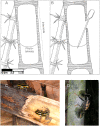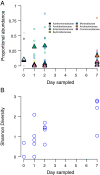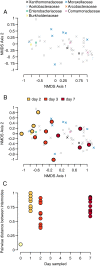Assembling microbial communities: a genomic analysis of a natural experiment in neotropical bamboo internodes
- PMID: 36132220
- PMCID: PMC9484453
- DOI: 10.7717/peerj.13958
Assembling microbial communities: a genomic analysis of a natural experiment in neotropical bamboo internodes
Abstract
Microbes participate in ecological communities, much like multicellular organisms. However, microbial communities lack the centuries of observation and theory describing and predicting ecological processes available for multicellular organisms. Here, we examine early bacterial community assembly in the water-filled internodes of Amazonian bamboos from the genus Guadua. Bamboo stands form distinct habitat patches within the lowland Amazonian rainforest and provide habitat for a suite of vertebrate and invertebrate species. Guadua bamboos develop sealed, water-filled internodes as they grow. Internodes are presumed sterile or near sterile while closed, but most are eventually opened to the environment by animals, after which they are colonized by microbes. We find that microbial community diversity increases sharply over the first few days of environmental exposure, and taxonomic identity of the microbes changes through this time period as is predicted for early community assembly in macroscopic communities. Microbial community taxonomic turnover is consistent at the bacteria phylum level, but at the level of Operational Taxonomic Units (OTUs), internode communities become increasingly differentiated through time. We argue that these tropical bamboos form an ideal study system for microbial community ecology due to their near-sterile condition prior to opening, relatively consistent environment after opening, and functionally limitless possibilities for replicates. Given the possible importance of opened internode habitats as locations of transmission for both pathogenic and beneficial microbes among animals, understanding the microbial dynamics of the internode habitat is a key conservation concern for the insect and amphibian species that use this microhabitat.
Keywords: Amazon; Bamboo; Microbial community-assembly; Succession.
© 2022 Ahluwalia et al.
Conflict of interest statement
The authors declare that they have no competing interests.
Figures



Similar articles
-
The aquatic communities inhabiting internodes of two sympatric bamboos in Argentinean subtropical forest.J Insect Sci. 2013;13:93. doi: 10.1673/031.013.9301. J Insect Sci. 2013. PMID: 24224775 Free PMC article.
-
Microbial Community Succession and Nutrient Cycling Responses following Perturbations of Experimental Saltwater Aquaria.mSphere. 2019 Feb 20;4(1):e00043-19. doi: 10.1128/mSphere.00043-19. mSphere. 2019. PMID: 30787117 Free PMC article.
-
The Global Genome Question: Microbes as the Key to Understanding Evolution and Ecology: This report is based on a colloquium, “The Global Genome Question: Microbes as the Key to Understanding Evolution and Ecology,” sponsored by the American Academy of Microbiology and held October 11-13, 2002, in Longboat Key, Florida.Washington (DC): American Society for Microbiology; 2004. Washington (DC): American Society for Microbiology; 2004. PMID: 33119236 Free Books & Documents. Review.
-
Microbes in Pipes (MIP): The Microbiology of the Water Distribution System.Washington (DC): American Society for Microbiology; 2013. Washington (DC): American Society for Microbiology; 2013. PMID: 32809306 Free Books & Documents. Review.
-
Beetles in bamboo forests: community structure in a heterogeneous landscape of southwestern Amazonia.PeerJ. 2018 Jul 3;6:e5153. doi: 10.7717/peerj.5153. eCollection 2018. PeerJ. 2018. PMID: 30002980 Free PMC article.
References
-
- Anderson MJ. A new method for non-parametric multivariate analysis of variance. Austral Ecology. 2001;26:32–46. doi: 10.1111/j.1442-9993.2001.01070.pp.x. - DOI
-
- Anderson MJ. Permutational multivariate analysis of variance (PERMANOVA) In: Balakrishnan N, Colton T, Everitt B, Piegorsch W, Ruggeri F, Teugels JL, editors. Wiley StatsRef: Statistics Reference Online. First Edition. Hoboken: Wiley; 2017. pp. 1–15.
-
- Barker K. At the Bench: A Laboratory Navigator. Cold Spring Harbor: Cold Spring Harbor Laboratory Press; 1998.
-
- Bazzaz FA. The physiological ecology of plant succession. Annual Review of Ecology and Systematics. 1979;10:351–371. doi: 10.1146/annurev.es.10.110179.002031. - DOI
-
- Bittleston LS, Baker CCM, Strominger LB, Pringle A, Pierce NE. Metabarcoding as a tool for investigating arthropod diversity in Nepenthes pitcher plants. Austral Ecology. 2016;41:120–132. doi: 10.1111/aec.12271. - DOI
Publication types
MeSH terms
Substances
Grants and funding
LinkOut - more resources
Full Text Sources

